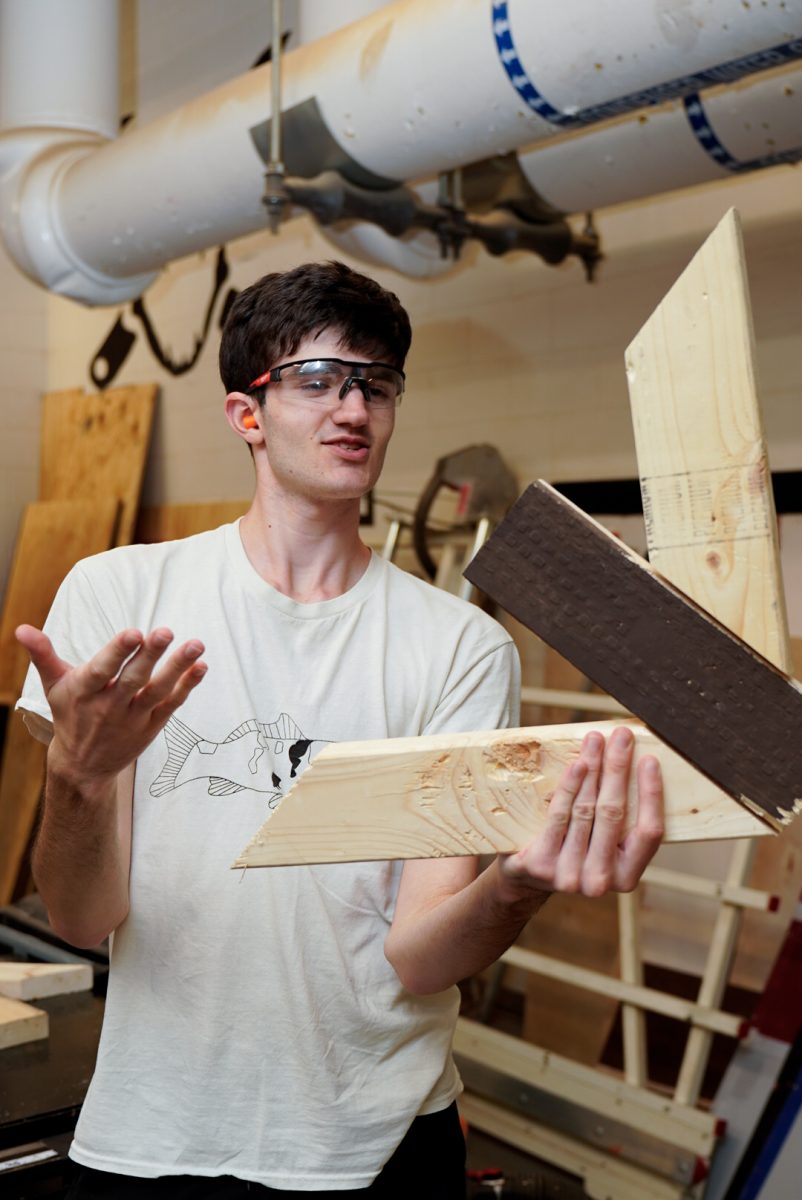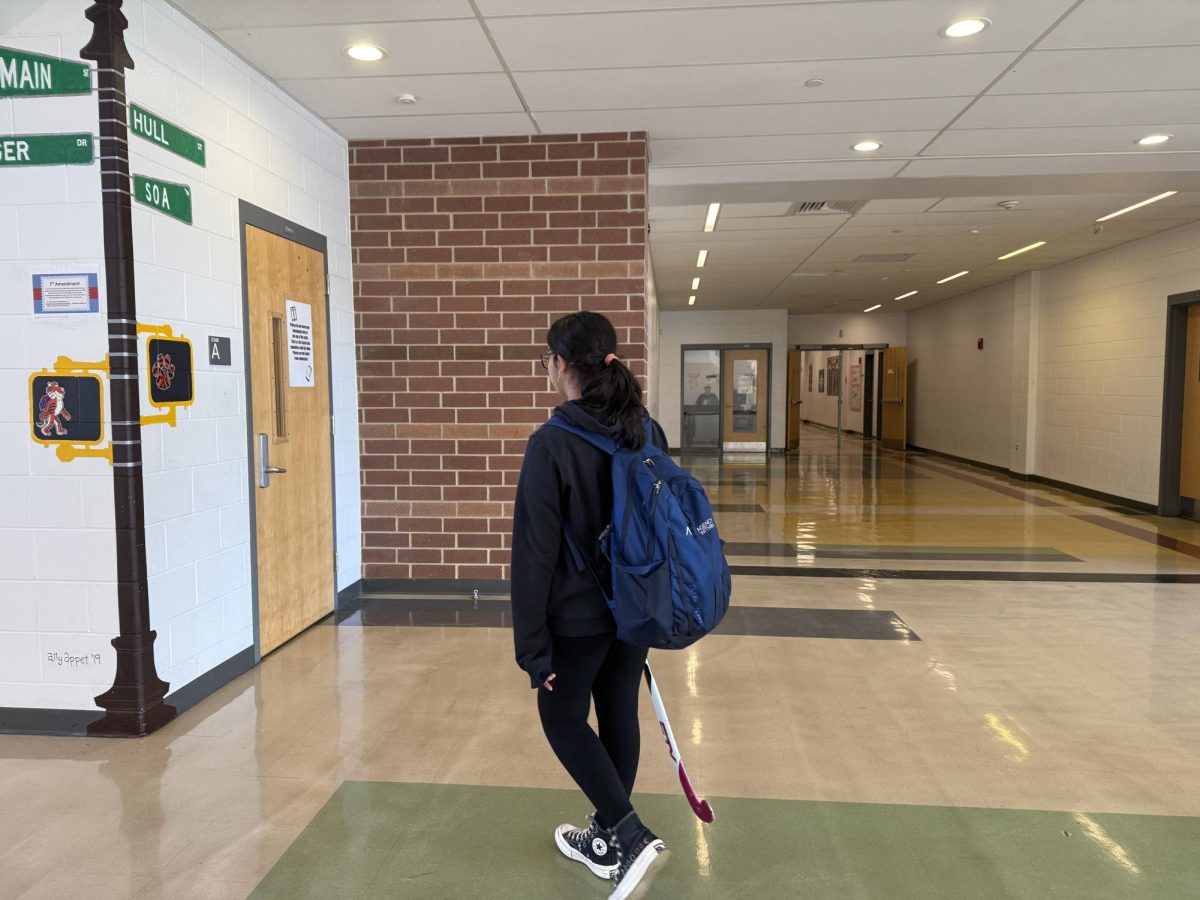by Perrin Stein
 [/media-credit]
[/media-credit]
- Senior Gwendolyn Stoll uses an iPad. After moving into the new building, this school invested in new technology.
When the Class of 2012 was in kindergarten, the City began to discuss ideas for renovations to both high schools. Over the next decade, renovation plans evolved from reconstructing portions of the old building for $39 million to creating an entirely new building for $197.5 million. The new building is the most expensive school ever built in Massachusetts.
In 2000, former mayor David Cohen proposed renovations to this school and South that would occur while school was in session.
Three years later, Cohen came before the public to announce that this school, unlike South, could not be renovated with students inside. In response to this problem, the former mayor created a committee to explore alternative reconstruction ideas.
The committee reported that a hybrid school, which is a school that includes both new construction and portions of an original building, would cost $94 million, and a new building would cost $108 million. With this information, the City focused on creating plans for construction of a new building.
In 2005, the City hired renowned architect Graham Gund to design the new building. Gund was not given a price limit, according to the Newton Tab.
Two years later, in January 2007, the final design plan was brought to the public in the form of a referendum. Sixty percent of voters approved the plan, so the construction process began.
Over the next year, the new building’s cost rose from $141 million to $170 million to $184 million. The increased cost resulted from a variety of factors, including excavation of underground remnants of Newton High School, according to the Newton Tab.
By September 2008, when the members of the Class of 2012 were freshmen, 57 percent of the structural steel for the new building was in place.
By February 2008, Cohen said the final price tag of the new building was to be $197.5 million.
When the final steel beam of the new building was placed December 12, 2010, the City celebrated with a “Topping off Ceremony.”
The new building earned a Leadership in Energy and Environmental Design Gold Certificate for a host of reasons, including energy-efficiency during construction, lights sensitive to daylight, windows that prevent heat escape, low-flow faucets and the usage of rainwater in toilets.
Throughout the winter and spring of 2010, former art teacher Sandra Truant led an effort to photograph and catalogue the murals that adorned the old building. Two large murals were saved to be placed in the new building. One currently hangs on Main Street, and the other is in storage, awaiting restoration.
The Naming Committee, a group dedicated to naming important locations in the new building, such as the auditorium, began accepting suggestions for names in February 2010. The Committee planned to look through the submissions and to send the best ones to the School Committee, which would make the final naming decisions.
Instead of using the Naming Committee’s proposal, this spring, the School Committee approved the Newton Schools Foundation’s campaign to sell naming rights in order to raise up to $5.7 million for technology for the NPS. Before the fundraising campaign can begin, the Aldermen must decide whether or not to create a revolving fund for the money earned from the sales.
To help with the 100-foot move to the new building, vice principal Deb Holman and the Move Committee organized approximately two dedicated “purge days” a month, which began in February 2010 and ended in June 2010. Work study students spent those days helping teachers throw away materials they would not need in the new building.
During the final weeks of the 2009-2010 school year and throughout the beginning of the summer, faculty and students packed everything that was not “purged” into bins, which would be moved to the new building.
About half of the furniture in the old building could not be moved to the new school because “it is damaged, broken or its quality is poor, or it does not meet the standards of the fire code,” principal Jennifer Price said at the time.
In August 2010, during abatement, the demolition crew discovered hidden polychlorinated biphenyls, asbestos and mercury. Some of these hazardous materials had been removed years ago. The discovery of additional hazardous materials pushed the demolition date back from early spring to mid-summer, according to chief operating officer Bob Rooney at the time.
The demolition cost $11.6 million, six percent of the entire project.
Mayor Setti Warren, superintendent David Fleishman, Price and Class of 2011 president Molly Doris-Pierce cut the ribbon to officially open the new building August 31, 2010. After the ribbon cutting ceremony, incoming seniors were allowed to tour the building before it opened to the rest of the student body.
With the change in building, came a loss of some of the characteristics of the old building, such as lunch on Main Street and posters hanging in every hallway.
Due to fire safety codes, in the new building, students are no longer allowed to post flyers wherever they desire. In October 2010, the school ordered bulletin boards, so students could post flyers outside the cafeteria and in other central locations in the building.
The new building includes much new technology including iPads, interactive whiteboards in every classroom, a document camera in every classroom and movement-sensitive lighting.
In October 2011, two Samsung 46-inch LED flat-screen televisions were installed in the cafeteria. Campus aides and housemasters control the channels.
In December, a 110-space parking lot bordering Lowell Avenue opened for faculty members. Their old spots on neighboring streets were delegated to students.
The following month, the Boston Society of Architects gave this school a 2011 Award for Design Excellence.
This winter and spring, the Student Faculty Administration designed and implemented a student union in the cafeteria as a spot for students to spend free time. The student union was created in response to a concern that students use the Library Learning Commons as a hangout spot rather than as a quiet study space.
The fields that will stand where the old building once did will be ready for use next fall.









































